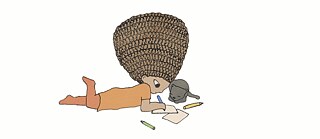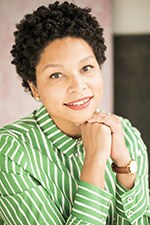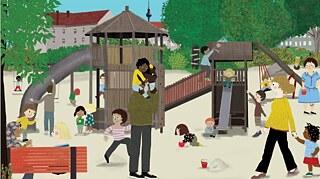Chantal-Fleur Sandjon
Hero(in)es wanted: Children of colour in picture books

Undaunted unicorns, adventurous snails, butterfingered ghosts – they can all be picture-book heroes and heroines. But what about Children of Colour,* are they just as likely to be placed centre stage? The Goethe-Institut Finnland invited me to spend two weeks finding out.

Tuikku inspires me – and Finland does too, in some respects. About 5.5 million inhabitants outperform Germany, not only in terms of life expectancy or Pisa results. Finland was the first European country to introduce women’s suffrage in 1906 and Sanna Marin, the world's youngest incumbent prime minister, has been in office since December 2019. And this home for Tuikku, a Black child, who is at the centre of a story that is not about experiences of racism, supposed strangeness, or otherness. A simple book, a quiet story filled with everyday life. You could call her ordinary, but it’s just this everyday and matter-of-course way in which Tuikku is portrayed that makes her so extraordinary.
“The lack of or often stereotypical portrayal of Children of Colour was the decisive factor for us to initiate a long-term project on diversity in children’s literature,” explained Isabel Hölzl, director of the Goethe-Institut Finnland. “Migration to Finland has increased rapidly in recent years. The composition of Finnish society today is still reflected far too little in children's books.”
ONLY ONE IN A HUNDRED BOOKS
At the end of 2019, I spent just over two weeks in Helsinki with the illustrator EL BOUM, drawing on our practical experience as writers and illustrators of Colour to help plan the Goethe-Institut project. We know that this imbalance in the representation of social diversity is not unique to Finland. The British Centre for Literacy in Primary Education (CLPE), found that a Child of Colour was the main protagonist in only 1% of published children's books in 2017, while 4% contained secondary characters of Colour. Germany and Finland have not done similar studies, but – unlike unicorns – the search for Hero(in)es of Colour in our children’s books is usually in vain. Tuikku author Johanna Lestelä criticizes this state of affairs: “I am a teacher at a very diverse school in Espoo. In my search for suitable books for the children here, I noticed that characters with darker skin are usually only the focus of attention in stories about diversity – otherwise, they are never more than secondary characters.”The main problem with this is that even at a very young age, picture books convey the apparently given order of all things, from social rankings to beauty ideals. Books accompany their readers. They help children to understand the world around them and their own place in it. When Children of Colour do not appear in the worlds that open up between two book covers at all or merely as shadowy marginal figures, they experience exclusion or othering all over again. Books like these can give white children the opportunity to encounter the realities of a plural society as completely self-evident. In two ways, the lack of diverse books is a missed opportunity – to represent plural identities and build democracy.
The Goethe-Institut Finnland wants to change this. In 2020, we are setting up and strengthening networks on diversity in children’s literature and supporting publishers in designing a more diverse programme. Hölzl explained: “At the same time, it is also important to us to collect good practice from different countries and to make good books that reflect the diversity of our societies and are accessible to a wide audience.”
But how should “good” be defined in this context, especially to distinguish well-intentioned from well-made books?
WHAT ARE GOOD BOOKS?
A comprehensive “Checklist for Evaluating Children’s Books for Prejudice” was published in 2018 by the Fachstelle Kinderwelten – Institut für den Situationsansatz (Children’s Worlds Office – Situational Approach Institute). This shows that we don’t just need more diversity in children’s books: how we do it matters. Is there a full diversity of characters? Are stereotypes avoided, including in portraying clothing and physical characteristics? Can all children appear with their own individuality, their very different interests, characteristics and abilities? Who is in an active role, contributes to problem solving, and has the chance to take the lead?Good therefore means many things. Good books approach diversity fairly – they reflect social diversity in who is active and who is at the centre of the story. Good books are critical of norms – they offer alternatives to social norms such as traditional gender roles or stereotypical attributions to people who know what it means to be a refugee or migrant. Good books are aware of prejudice – at the production stage they assume the need to examine one’s own positioning, prejudices and ways of excluding others.
These are big terms with some overlaps. The overall aim is the same: books for the youngest children should be books for all children. They should support children to develop a positive self-image and to dream – not only about talking unicorns, snails and ghosts, but also about their own place in the world and the manifold forms this can take.

Good books by all for all!
The bilingual picture book Traumberufe (Dream Professions, Viel & Mehr, 2014, age 4+) invites you to dream about your career aspirations regardless of origin, gender, disability or social status. Dreams and self-determination are at the heart of the new title Julian ist eine Meerjungfrau (Julian is a Mermaid, Knesebeck, 2019, age 4+), in which a Black boy longs to be a mermaid. In the series Nelly and the Berlinchen (Nelly and the Berlin Girls, Hawandel, 2016 and 2019, age 4+) the Afro-German protagonist makes plans, solves puzzles, has fun and gets angry. Wide worlds of feeling open up for Children of Colour and white children alike in these books, too: Meine wilde Wut (My Wild Rage, Beltz & Gelberg, 2018, age 4+) and Ich bin jetzt ... glücklich, wütend, stark (Now I’m... Happy, Angry, Strong, Carlsen, 2017, age 3+).Good books for all means books written and illustrated by all, because our own perspective shapes not only how we perceive the world, but also how we describe it. In the long term, more diversity behind a children’s book leads to more diversity in the children’s book itself, simply by the writers and illustrators implicitly or explicitly bringing their own everyday life and reality into the story – even with unicorns, snails and ghosts.
*People of Colour: self-designation instead of discriminatory third-party designations by and for people with experiences of racism.
**Black: also capitalized as an adjective as an empowering and resistant self-designation for people of African origin.
The article was first published in the February 2020 issue of Eselsohr – the German specialist journal for children’s and youth media.